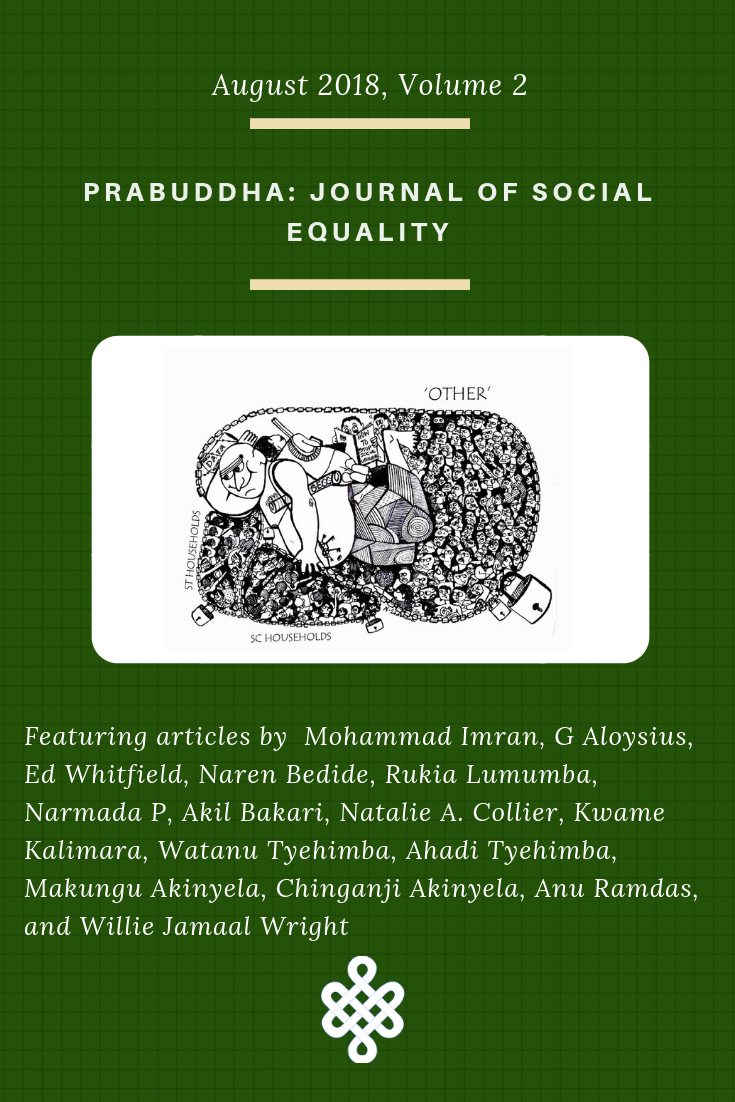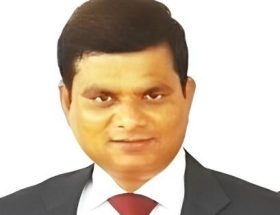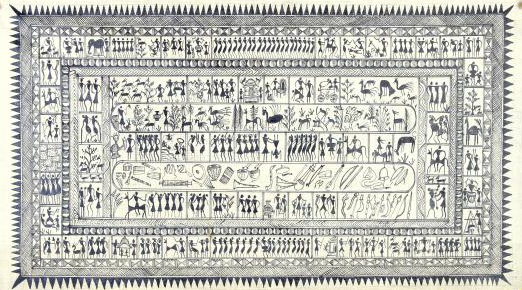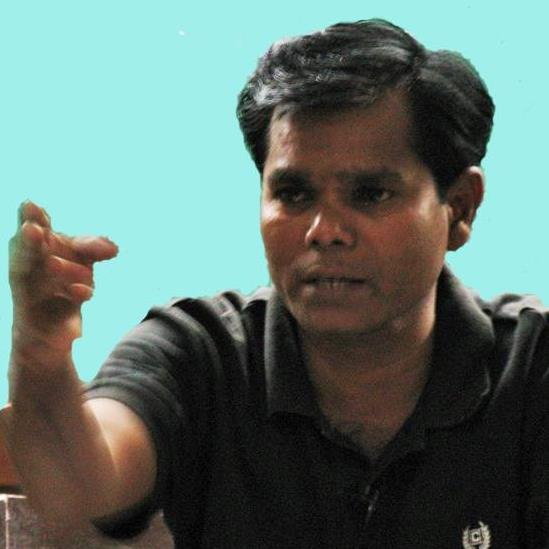Naren Bedide (Kuffir)

The second issue of Prabuddha: Journal of Social Equality carries articles by authors from anti-caste traditions and black liberation movements exploring the myths of inherent essence or “svabhava” of humans. Authors from the anti-caste traditions examine ‘The Brahmin Svabhava—uninterrupted access to surplus, labor, and property over the ages.’ And authors from Black liberation movements examine ‘White supremacy and its uninterrupted access to surplus, labor, and property over the ages.’
The Brahmin Keeps India in the 18th century
In this interview, the caste mode of production is discussed as a perplexingly unexplored area of economics, politics, and sociology in India. The role, relationship and negative impact of the ruling class composed of the Brahmins and upper castes on the Bahujan majority are highlighted.
Rakesh S Ram: Is there a Brahmin Svabhava? How do we recognize it?
Naren Bedide (Kuffir): Is there a Dalit Svabhava, or OBC Svabhava? If we think of ‘svabhava’ as ‘intrinsic nature’, its literal definition, then we make the mistake of essentialising: neither the Brahmin nor the Dalit nor OBC can be described as having any intrinsic nature or svabhava. But what do those terms convey? Roughly, they could be said to describe the social position/conditions those groups of people belong to, live in. But when such positions/conditions remain unchanged over a long, long period of time, there is a tendency to confuse them with the svabhava of the said groups. And that’s how the term Brahmin has come to be associated with ‘a cultured person from a long-established upper-class family, esp. of New England, regarded as haughty or conservative’ or an ‘an intellectual or social snob’, several continents away, not just ‘a Hindu of the highest social rank’ or just a ‘priest’, by several dictionaries.
As one can see, the term Brahmin has come to be universally assigned with many positive attributes (and a few negative ones): ‘cultured’, ‘intellectual’ etc. The New World Encyclopedia showers much more praise: ‘scholar, teacher, priest, intellectual, researcher, scientist, knowledge-seeker, or knowledge worker’.
Has a social position become a svabhava?
Not really, the Brahmin is still part of the human race, but this universalisation of his entrenched rank as a positive quality only speaks of his vaibhava, more than his svabhava. Vaibhava in Sanskrit has several meanings which could more than adequately fit Brahmin-ness: ‘glory’, ‘grandeur’, ‘power’, ‘greatness’, ‘high position’, ‘magnificence’ etc.[1]
So that’s how we can recognize the Brahmin: through glory and power and high position, in every field. Or as Babasaheb put it very simply, sometimes, we recognize them as the ‘governing class’.
Rakesh: What is the core social issue: the Brahmins, Brahminical practices or Brahmanism?
Kuffir: It is considered de rigueur in academia to talk of the brahminical, but not of the Brahmin himself. That is considered extreme bad manners, almost. But the Brahmin doesn’t go away just because you say he doesn’t exist and only the brahminical does.
Can the term brahminical be applied to anyone but a Brahmin? The term rests on the presumption of knowledge of the essence of the Brahmin. If you know what it takes to be brahminical, can you become a Brahmin? You can become a Christian, a capitalist or a Marxist or an astrologer if you want, after gaining knowledge of what they are. But you can’t become a Brahmin even if you think you know all the answers to that.
One could say, you could learn all about Arabs or the French or the house of Windsor but could never become any of them either. But as Anu Ramdas says:
The Brahmins do not have any racial distinctness to be classified as a racial group separate from the rest of Indians, nor are they an ethnic group emerging out of common ancestry, or territory or culture. They, like the rest of the castes belong to many subcastes, speak many languages and hail from many regions and are strictly endogamic. In other words, there are no kinship relations holding all the Brahmins together.[2]
The essence of a Brahmin can’t be defined by occupation either. To define them as traditional priests or clergy hardly does them justice: they’ve been kings, ministers, warriors, medicine men, landlords, teachers, writers, clerks, judges etc., from the very beginning.
It’s clear the essence of the Brahmin, or the Brahmin svabhava, is very difficult to define. Do they exist? They have been around for around for 2,500 years at least. They exist, but they can’t be defined. That’s the reverse of the first ontological argument: God exists because even the denier can imagine the idea of the greatest being in the universe, if God is defined as the greatest being in the world. Therefore, it is possible to describe someone as Godly, but how can anyone be called brahminical when the Brahmin can’t be defined at all?
To recapitulate: first, you can’t become a Brahmin even if you know the essence of what it means and want to become one. Second, you can’t know the essence of a Brahmin even though he has been around for 2,500 years.
Ok, that’s ‘Brahmin’ and ‘Brahminical’—so what’s ‘Brahmanism’? Babasaheb says:
It is a religion which is not intended to establish liberty, equality and fraternity. It is a gospel which proclaims the worship of the superman—the Brahmin—by the rest of the Hindu Society. It propounds that the superman and his class alone are born to live and to rule. Others are born to serve them, and to nothing more. They have no life of their own to live, and no right to develop their own personality. This has been the gospel of the Hindu Religion.[3] (Ranade, Gandhi and Jinnah)
How can there be any Brahmanism without any Brahmins to serve? We needn’t read any universal purpose into it. What Babasaheb accurately describes above sounds more like a political philosophy than a religion. A political philosophy or agenda more narrow in its vision and purpose than Nazism or Zionism. That is why, in these ‘modern’ times, the Brahmins keep changing its name – from Brahminism to Hinduism to Sanatana Dharma to Hindutva to camouflage its only purpose.
So, the core social and political and economic issue is what? A group of people entirely wedded to themselves, to their own interests over centuries, who have influenced the social, political and economic contours of Indian society, apart from its religious structures.
But the strangest part is that a group that’s not defined by language or any racial characteristic or ethnicity or occupation is often confused with one of those associations. Can you think of any other group that’s been around for around 2,500 years, unconnected by language, race, ethnicity, occupation? You can’t. Therefore, people assume they must be much more successfully sectarian than anyone else.
It would make much more sense to think of them as a self-serving group, plainly. One with an acute sense of class consciousness from the very beginning. Babasaheb says:
The centre of the ideal (of Hindu social order) is neither individual nor society, it is a class, it is a class of supermen called Brahmins …. It holds that to be right and good the act must serve the interest of a class of supermen, namely the Brahmin. Anything which serves the interest of this class is alone entitled to be called good.[4]
The Brahmin has his ideological roots in religion, occupying the very centre of it, but in practice he couldn’t enjoy formal political leadership in all places and times. From the beginning, his politics must have centered around establishing his priority claim on surpluses. To institutionalize his ‘life of leisure’ against a ‘life of labour’, as Kancha Ilaiah says. This ensured his concrete position in society was always at the top, whatever the ruling dispensation—Hindu, Buddhist, Muslim or the British. The fall of any kingdom or empire didn’t disrupt his position much because his high status in the old establishment always meant he was in a more advantageous position than others to seek a similar slot in the new establishment. This meant that his ideological projection of himself as a ‘superman’ was always backed by assured material security and vice versa. This also implied that he was condemned to a life of social isolation—from his rivals at the top of society and his detractors at the bottom. All these developments in turn made the Brahmin more inward looking, deaf and blind to anything but his own class interests and expecting every other class to respect his interests first, as Babasaheb would say. Enclosing himself more, making him uniquely Brahmin. How can anyone else be a Brahmin, Brahminical or truly follow Brahmanism? Can anyone be Dalit?
Rakesh: What has been the Brahmin svabhava’s imprint on India’s society?
Kuffir: How would we know? Ambedkar was perhaps the last thinker to speak about its imprint, how the Brahmins have been a disaster for India as an ‘intellectual’ class, as a ‘governing class’.
But what India’s social and political scientists have been doing, or not doing, for the last 70 years is very strange. You don’t find the academia or media or civil society talking about the Brahmin ever. It’s not that they don’t talk about caste, or dominant castes or upper castes in particular. You’ll find reams of stuff on Bhumihars, Rajputs, Kayasthas, Khatris, Patels, Marathas, Jats, Reddies, Kammas, Lingayats etc., and politically significant OBC communities like Yadavs, Kurmis, Lodhs, Vokkaligas, Thevars, Ezhavas etc. They will even talk of the larger Dalit communities like the Mahars, Chamars, Paraiyars etc. But very little on the Brahmin.
It’s like they had shaved off the top of the hierarchy that Ambedkar had talked about. They don’t seem interested in the Brahmin at all. They’ll probably present Apartheid South Africa as being ruled by colourless people. India’s intelligentsia can’t spot the Brahmin in the room.
It seems, Brahmin hegemony is a fait accompli: the Indian ‘nation’ can’t discuss it, only accept it and move on.
Move on to Bania capitalism or Kamma capitalism or Bhumihar feudalism or Dalit ‘rightward shift’ etc. The last trope is very interesting because it was coined by a Brahmin professor in a central university. He has a brother who is also a professor in a central university. Interestingly, their father was also a professor in a central university until recently. Hereditary professors.
We also have hereditary judges, hereditary editors, hereditary scientists, hereditary doctors, hereditary engineers, hereditary mandarins in government, hereditary corporate directors and executives, hereditary award-winning writers and poets, hereditary bankers, hereditary filmmakers etc.
Yes, you would find some other upper castes also occupying such positions, but their domination is confined to certain regional pockets and even there, they’re not as excessively over-represented as the Brahmins. The institutions that formally signify modernity in India are basically a Brahmin space. How did that happen, shouldn’t that pique the interest of any reasonably competent social scientist?
Don’t they remind you of the institution of fiefs in the feudal age? But, instead of land grants, what the beneficiary gets here is exclusive control over these institutions. And as this is a democracy, at least nominally, these rights are not granted to individuals or clans but are distributed across Brahmin caste/s, and other upper castes to a less significant extent.
Modernity tells you that all men are equal; that no one has any superior, or ‘divine’, qualities. But it also tells you to question and challenge anyone who enjoys superior entitlements and privileges for a long period of time.
It’s not good enough if you keep telling yourself that caste is pre-modern, now we have access to modern, equal rights etc. Tell that to the Brahmin. When he and his cohorts own the whole neighbourhood and the city, how will the thought that we’re all equal ever occur to him? He naturally thinks constitution and rule of law are meant to protect his democratic ‘rights’ which in reality are a pre-modern tithe, for all purposes. Modernity has been going through a long, 200 year long, period of pregnancy in India. Can we be sure that it’ll be born even in this century ..? Left to the Brahmin, he would keep India in the 18th century forever.
A very modern angst permeates the Bahujan masses across India. In contrast, there’s a strong perception that Brahmins are a ruling class from a pre-modern era, with a pre-modern consciousness of supremacy, whose politics over the last few centuries have been to choke modernity of all its liberatory potential by gaining total control over all the nodes of the country’s political economy, leveraging its earlier vantage position in Indian societies.
What is the effect of this overwhelming Brahmin hold over both repressive and ideological apparatuses of the state—has this even been acknowledged so far, or studied?
But what is clearly visible to any keen observer is this: India hovers at the bottom, lower than most of the world’s poorest countries, in any global human development or human capital rankings, it has over one-third of the world’s poor, it has the largest number of people still suffering under slavery, it has the largest number of out of school children and child labourers, it has the largest number of landless farmers, it has the largest number of malnourished women and children in the world and so on. It has also perhaps the largest number of farmer suicides, sanitation worker suicides, artisan suicides, starvation deaths, honour killings, dowry deaths, and infant deaths and so on.
Rakesh: What is the Brahmin’s role in India’s political economy?
Kuffir: All that I described earlier, in relation to the Brahmin and Indian society, that is all about the Indian economy too. The Indian Marxists overemphasize the role of ownership of means of production in determining the nature of India’s political economy. What matters is not literal ownership but control over the reins of production.[5]
The Brahmin, with his upper caste collaborators, doesn’t just control the state and the corridors of power, but also exercises monopolistic clout over the flow of capital in the country. As members in the boardrooms, along with the Banias, they direct over 90% of India’s capital.
The key players in the nationalist project, the landowning castes and the mercantile castes from various nations now submerged in India, along with the Brahmins have expanded their economic power several times since independence. The key source of accumulation and power in rural India, land, still remains majorly in the control of a handful of castes in each region. Sometimes, as much as 85% of agricultural land is owned by one caste in a particular state.
Recent global studies of wealth inequality have pointed out that over 95% of wealth in India is owned by a mere 10% of the population. Who else but the Brahmins and the upper castes own this wealth?
You could say the Brahmin is both the head and the belly of the Indian economy, in a manner of speaking. He decides what India produces, because he controls the organized sector which in turn colonizes the unorganized sector. He also decides what it consumes, because he leads India’s middle class which is barely one-fifth of the population and should rightly be called upper class because of all the power it wields, socially and politically, composed as it is of the traditional aristocracy like the Brahmins and other savarnas, and the handful of ‘shudra’ dominant castes in each state who had benefitted immensely from the colonial apportioning of the largest, the most productive chunks of land to them.
This was borne out by the situation that unfolded after the ‘demonetisation’ event two years ago: I had done some rough calculations based on the SECC 2011 (Socio-Economic Caste Census-2011) consumption figures, and the Rangarajan and Tendulkar Committee estimates of the poverty line, and concluded that all the Bahujans in India spend around 6 times less than what the Brahmins and upper castes spend. In other words, every Brahmin-upper caste individual spends around 20 times more than every Bahujan individual every day.
These are at best guesstimates, severely hampered by the lack of caste-wise data, but they do give you a picture of the larger Indian reality.
Please read the full article here: Prabuddha: Journal of Social Equality
[1] SpokenSanskrit.org ( http://spokensanskrit.org/index.php?tran_input=vaibhava&direct=se&script=ia&link=yes&mode=3)
[2] Ramdas, A. (2015) The Brahmin Problem (http://roundtableindia.co.in/index.php?option=com_content&view=article&id=8104:the-brahmin-problem&catid=119:feature&Itemid=132)
[3] Ambedkar, B.R. (1943) Ranade, Gandhi and Jinnah (http://www.columbia.edu/itc/mealac/pritchett/00ambedkar/txt_ambedkar_ranade.html)
[4] Ambedkar, B. R. The Hindu Social Order: Its Essential Principles, p-72 (https://www.mea.gov.in/Images/attach/amb/Volume_03.pdf)
[5] Kuffir, N. (2017) Bahujans and Brahmins: Why their realities shall always collide, not converge. ( http://roundtableindia.co.in/index.php?option=com_content&view=article&id=9156:bahujans-and-progressive-brahmins-adversaries-not-allies&catid=119:feature&Itemid=132).
~~~
Rakesh S Ram is a member of the editorial team of Round Table India. This interview was conducted for PJSE’s special issue on ‘Brahmin Svabhava—uninterrupted access to surplus, labor, and property over the ages.’
To cite this article: Bedide, N. (2018). The Brahmin Keeps India in the 18th Century. Prabuddha: Journal Of Social Equality, 2(1), 26-33. Retrieved from http://prabuddha.us/index.php/pjse/article/view/30










